While I frost most of my cakes with American buttercream, sometimes I like to mix things up! After a bit of trial and error, I feel like I have finally mastered this chocolate Italian meringue buttercream (IMBC).

This type of frosting definitely takes a bit more effort than my chocolate American buttercream, but it isn’t as difficult as you might think.
It also is more stable and less finicky once it’s made! My favorite thing about Italian meringue buttercream is that it doesn’t crust. You don’t have to cover it with plastic wrap or worry about your frosting crusting on your cake if you make it in advance.
I find that I prefer my Italian meringue buttercream with a little more sugar and slightly less butter than most IMBC recipes call for.
While half the battle of IMBC is having a good recipe, the other half is how you make it!
That’s why I’m also walking through everything you need to know to make the smoothest, fluffiest chocolate Italian meringue buttercream frosting in this post.
Step #1: Room Temperature Egg Whites
What gives this frosting its incredible texture is the meringue that it’s made with. That’s why the eggs in this recipe are so important. Or more specifically the egg whites!
If you’re not quite sure what to do with the egg yolks you’ll be left with after making this frosting, here’s a great post with loads of ideas for using up leftover egg yolks.
You want to make sure the egg whites are at room temperature when you make this frosting.
Room temperature egg whites whip up better and faster than egg whites that are cold.
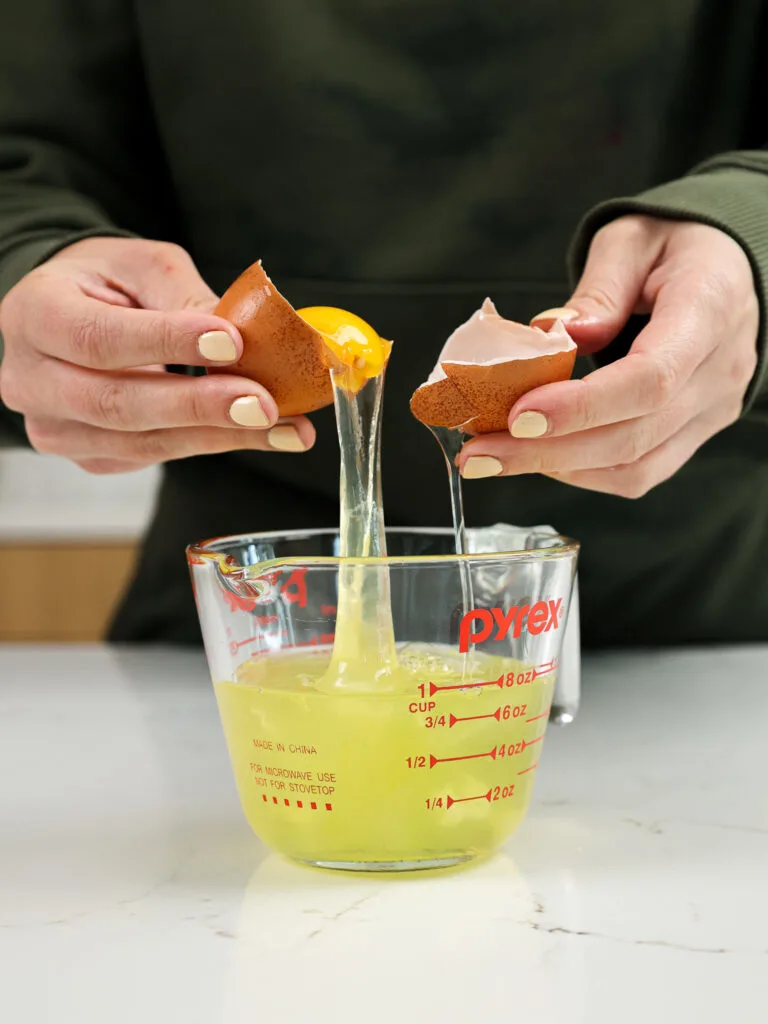
I suggest separating your eggs about an hour before you plan to make your frosting. Be careful as you do this, because they won’t whip up properly if any yolk gets into the mixture!
Normally I’m a huge fan of using egg whites out of a carton, but that’s when I’m adding them into batter. Carton egg whites simply don’t whip up as well when it comes to meringue.
I’m not sure if the pasteurization process does something to the protein in the egg or what, but I don’t recommend using egg whites from a carton to make Italian meringue frosting.
Step #2: Whipping Up Your Egg Whites
Next, it’s time to whip up the egg whites and add a bit of salt. This happens quite quickly and usually takes about a minute when mixing with a whisk attachment on a high speed.
You could in theory make this chocolate Italian buttercream with a hand mixer, but it would take forever!! Making it with a stand mixer is much easier and quicker.
Step #3: Making the Egg Whites Safe to Eat
There’s something about the idea of making frosting with raw eggs that seems a bit creepy. A lot of people worry it isn’t safe to eat, but we take an important step to ensure it is!
While the egg whites are whipping, we heat a sugar syrup to 240 F / 116 C and pour it into the egg whites while they mix. This kills any potentially harmful bacteria and make the frosting safe to eat.
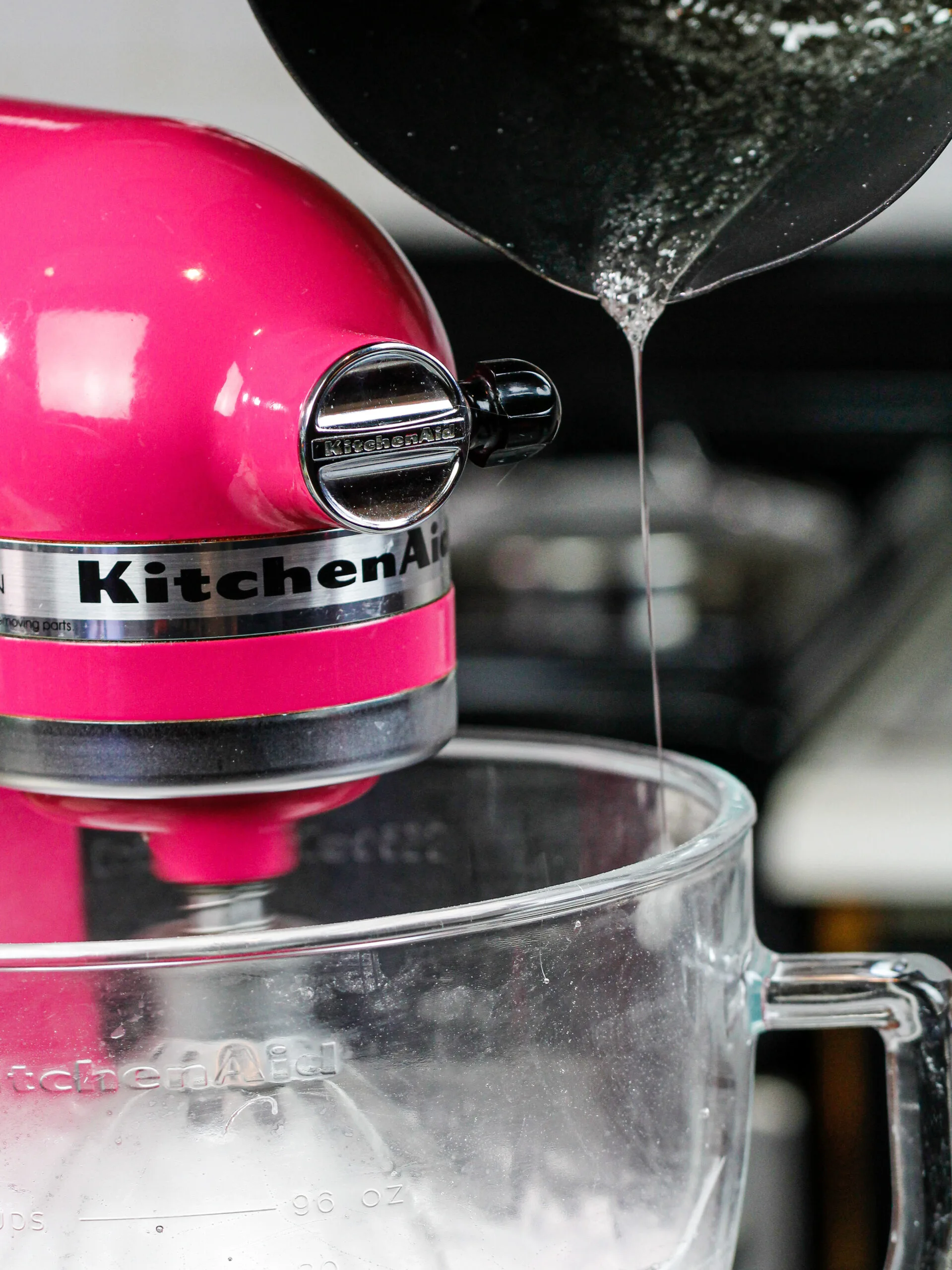
Step #4: Making Meringue with Stiff Peaks
After whipping the egg whites while pouring in the hot sugar syrup, the meringue should form stiff peaks. Stiff peaks are when meringue can stand up on its own when flipped upside down.
If you’re having a hard time knowing when the meringue reaches this stage just by looking at the mixing bowl, feel free to turn off your mixer and test the meringue by removing your whisk attachment and flipping it upside down.
It should look like the picture below at this stage.
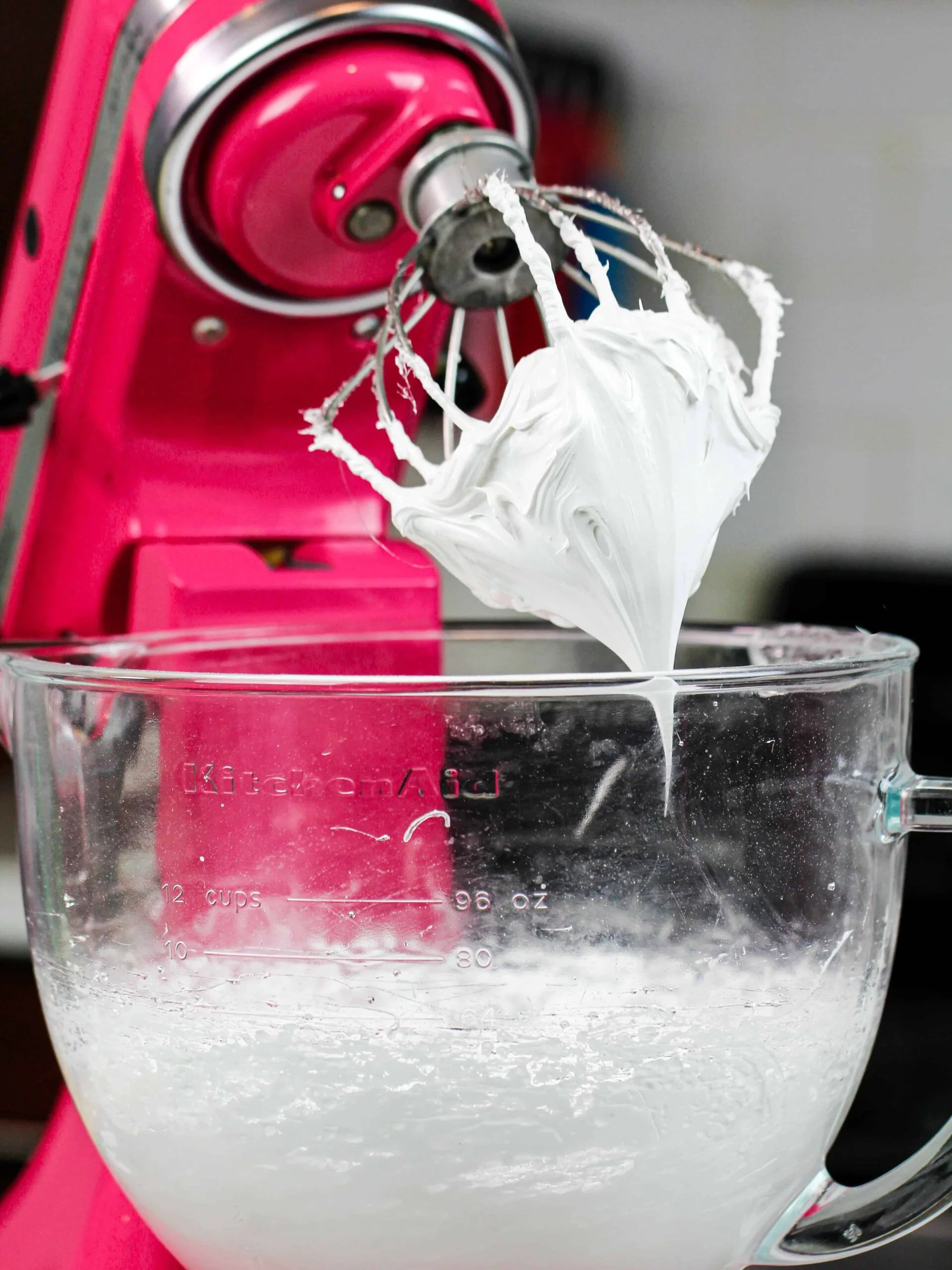
Step #5: When and How to Add in Your Butter
Once the meringue has stiff peaks and has cooled to room temperature, it’s time to mix in the unsalted butter.
During this step I like to feel that bottom of my mixing bowl with my hand.
If it feels pretty much room temperature, I add in my butter.
If it still feels warm, I’ll wait a few more minutes before adding the butter and place some frozen veggies or berries around the base of my bowl to help it cool down.
If the meringue and bowl is still warm when you add the butter, it can result in buttercream that’s too thin or soupy.
When I add in the unsalted butter, I do it in small chunks. This gives the meringue time to incorporate the butter and helps it mix together more easily.

As you add the butter, it’s super important that the butter is room temperature. This does NOT mean soft to the touch or greasy.
Most sticks of butter come to room temp in about 2 hours. Don’t let your butter doesn’t sit out much longer than that or it may become too soft.
It should be soft enough for you to be able to press your finger into but firm enough that you have to apply a bit of pressure to do so.
Step #6 Adding in the Chocolate
The final step is to add in the melted and cooled chocolate. I like to melt it at the beginning of this recipe because it needs time to cool before it’s added to the frosting.
You can heat the chocolate with a double boiler or a microwave.
If you use a microwave, heat the chocolate in 15 second intervals. Stir between intervals to help the chocolate heat more evenly.
Once the chocolate is mostly melted (usually takes 4 intervals for me) with a few bits of chocolate still intact, let the chocolate sit for a minute.
This will allow the heat from the bowl to melt those last bits of chocolate and prevent your chocolate from overheating.
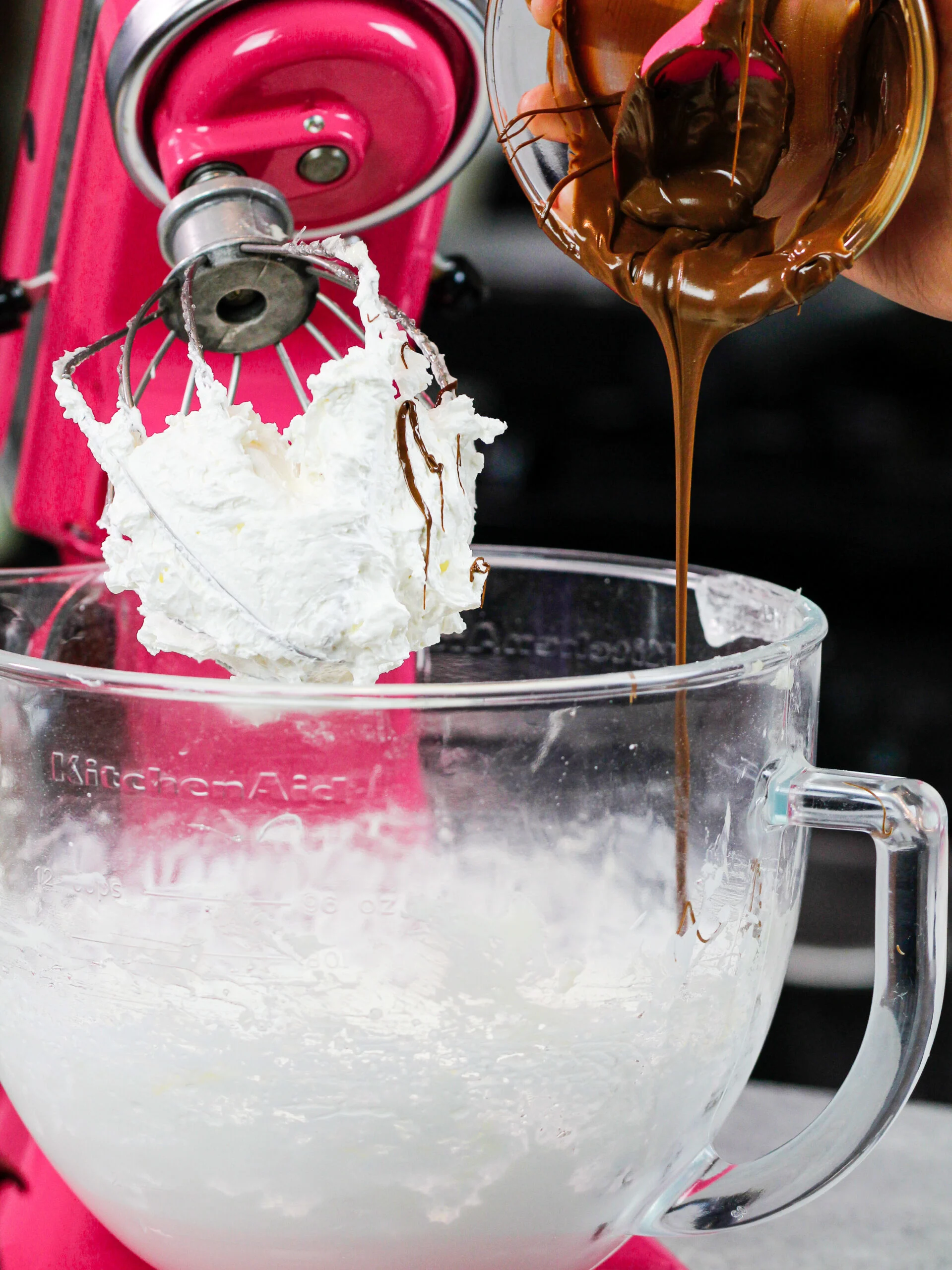
If the chocolate gets too hot, it can seize up and become chunky. Stir the chocolate until it’s smooth, then set aside to cool.
When the chocolate is no longer hot to the touch but still fluid, mix it into the buttercream with a bit of vanilla and you’re done!!
IMBC Troubleshooting
Two of the most common issues people run into when this type of frosting are curdled or soupy frosting.
While it might seem terrifying to watch this happen, fear not. Both problems are actually pretty easy to fix!!
How to Fix Curdled / Broken Italian Meringue Buttercream
A lot of different things can cause your IMBC to break or curdle.
Maybe the butter was too cold, or your kitchen was too chilly. Maybe you were thawing a batch of buttercream made in advance and it hadn’t fully come to room temperature before you started mixing it.
Whatever the reason, your frosting looks chunky, dense, and greasy.
Don’t worry, your frosting isn’t ruined! There’s an easy work around that will bring your frosting back together.
Simply place your bowl over a hot water bath / double boiler until the frosting around the edge of the bowl has melted. Then give it a good mix for several minutes.
The melted, warm frosting around the edge of the bowl will mix with the frosting that’s too cold.
This will bring the overall temperature of your frosting up to the right temperature and allow it to become smooth again.
How to Fix Soupy Italian Meringue Buttercream
On the other hand, if your frosting is too warm it might become a soupy, runny mess.
This can happen if your meringue is too warm when you add the butter or if the butter is too warm. Or maybe the chocolate was too warm, or your kitchen is too toasty!
If the frosting isn’t sturdy enough to keep its shape, you need to cool it down. To do this, just pop the mixing bowl and whisk right into the fridge.
I like to chill my bowl for about 15 minutes. At this point the center might still be a bit soupy but the frosting along the sides should be firmer. Mix it for a few minutes to see if it comes together.
If after 3-4 minutes of mixing it still looks too soft, chill the bowl for another 10 minutes before mixing it again. That usually does the trick!
Substitutions & Swaps
This chocolate Italian meringue buttercream recipe use quite a few ingredients and you might not have them all on hand.
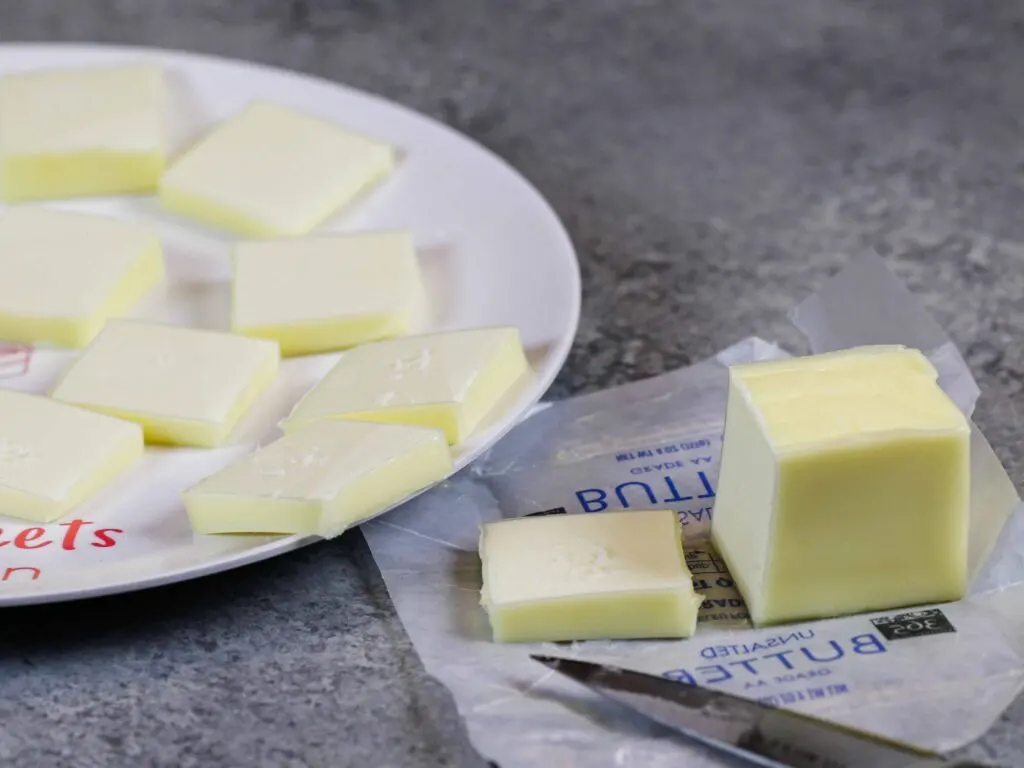
Below are some swaps and substitutions that you can make.
- Unsalted Butter – If you only have salted butter on hand, you can use it in place of the unsalted butter, just omit the salt that the recipe calls for. You can also use vegan butter in its place.
- Dark Chocolate – you can use milk, dark or semi-sweet chocolate to make this chocolate frosting! Just be sure it’s a good quality chocolate so it will melt down smoothly.
- Vanilla extract – You can use other extract in place of the vanilla! Almond, coconut, or even orange would taste great with the chocolate in this recipe.
- Espresso powder – This ingredient is optional and can be omitted. I like to add it because I think it really enhances the flavor of the chocolate in this frosting.
Tips For Making the Best Chocolate Italian Meringue Buttercream Frosting:
- Traces of grease in your mixing bowl can prevent your meringue from forming stiff peaks. Wipe down your bowl and whisk attachment with lemon juice or vinegar to make sure they’re grease-free.
- Use room temperature egg whites; they whip up more quickly and easily than cold egg whites.
- Closely watch the temperature of your sugar mixture, and remove it from heat as soon as it reaches 240 F / 116 C.
- Whip the meringue until its peaks are stiff enough to defy gravity.
- Make sure your butter is actually at room temp and add it in gradually (1 Tbsp at a time).
- When in doubt (if your frosting breaks / curdles), just keep mixing!! It should come back together with the help of your stand mixer.
- If you want smooth frosting for a cake, mix your finished buttercream on the lowest speed with a paddle attachment for a few minutes to make it super smooth.

Making This Chocolate Italian Meringue Buttercream in Advance & Storage Tips
Make this frosting ahead of time or save any leftover frosting! It can be stored in an airtight container at room temperature for 1 day, in the fridge for up to a week, or in the freezer for up to 3 months.
If made in advance, re-whip the frosting once it thaws to room temp to get the consistency nice and fluffy again.
A frosted cake can last in the fridge for up to a week, or in the freezer for up to a month. The buttercream locks in all the moisture, keeping the cake fresh and delicious!
If you cut into the cake and have leftovers, use any remaining frosting to cover the cut section to keep it moist and store in the fridge for up to a week.
How Much Frosting Does this Recipe Make?
One batch of this recipe makes about 2 cups of frosting. I find that’s enough to frost about a dozen cupcakes.
This recipe can easily be doubled to frost a 6 inch or 7-inch layer cake.

Let Me Know What You Think!
If you try this recipe for chocolate Italian meringue buttercream frosting, I’d love to hear what you think of it! Please leave a rating and comment below.
And don’t forget to tag me @chelsweets and use #chelsweets so that I can see your amazing creations on social media.
Other Recipes You Might Like:

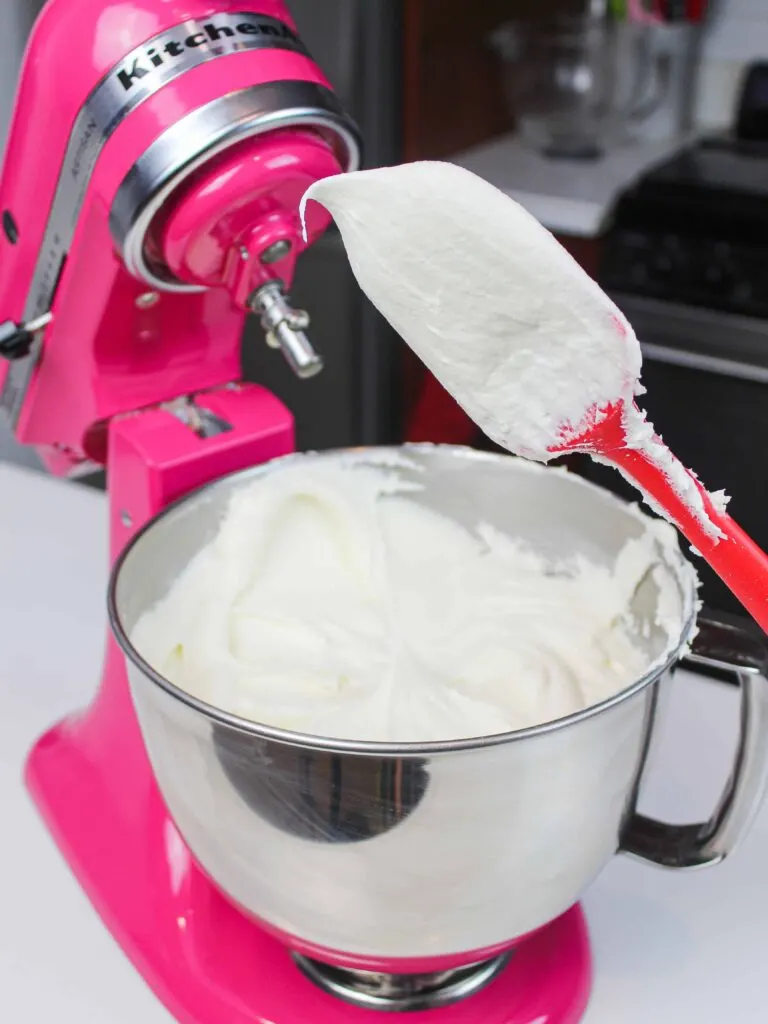
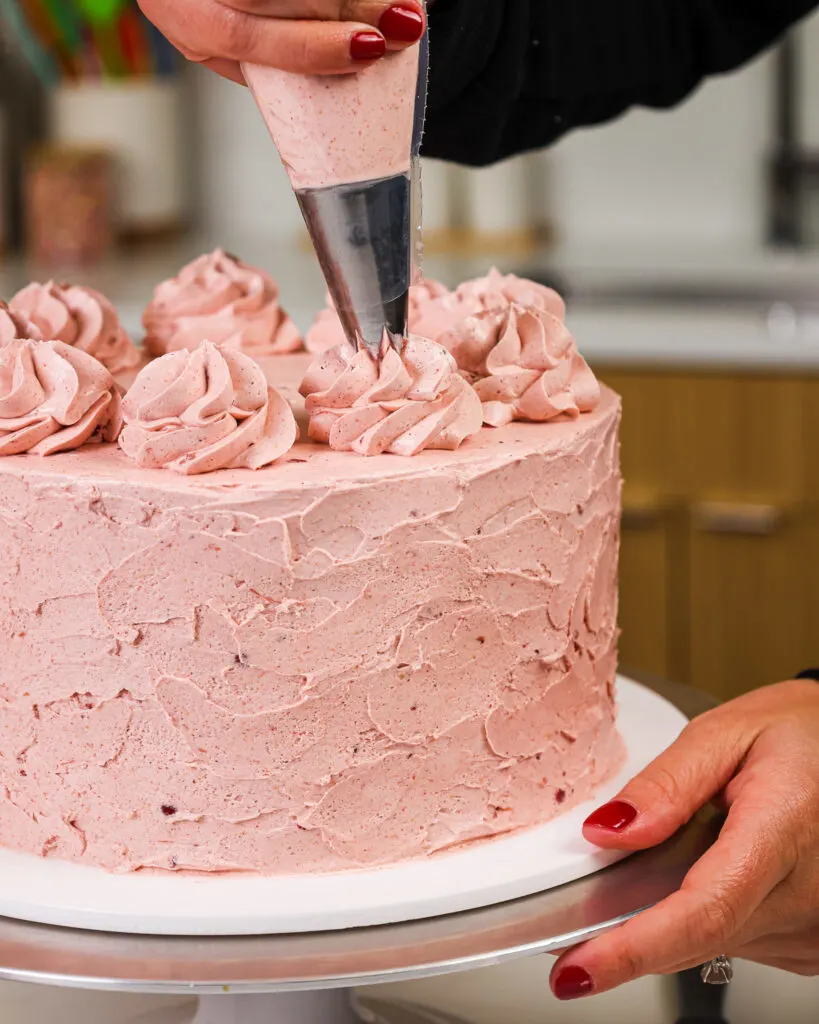
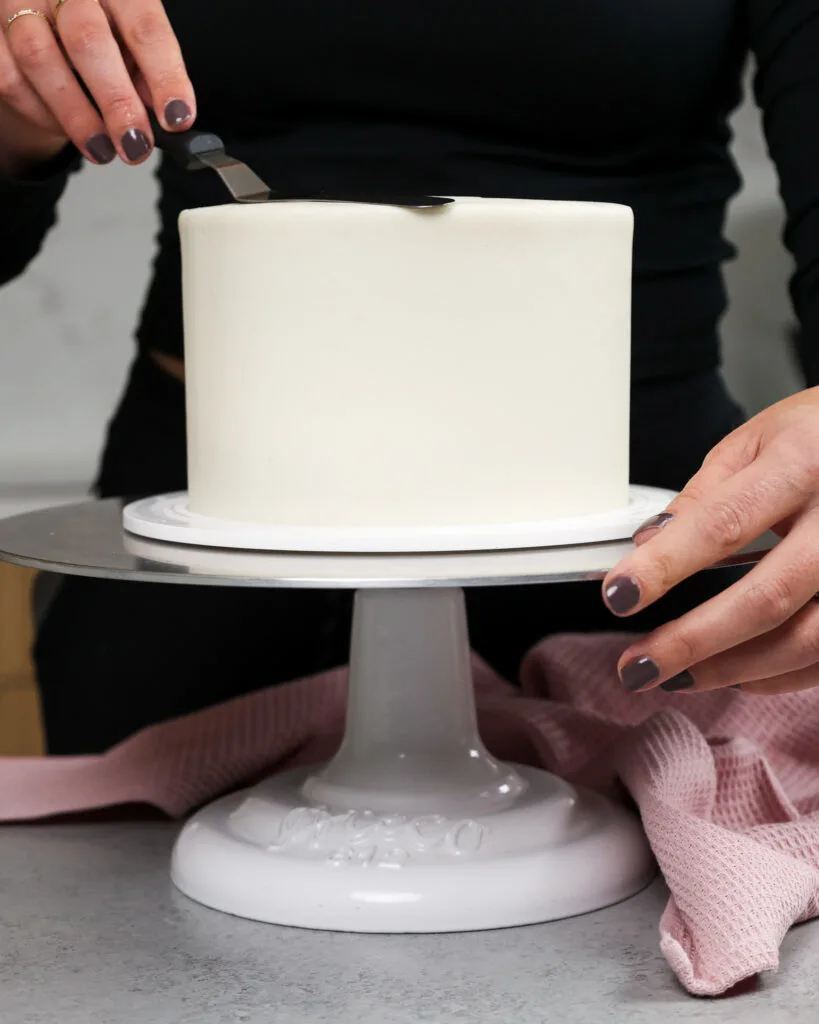
Chocolate Italian Meringue Buttercream

This chocolate Italian meringue buttercream frosting is packed with chocolate and has a wonderful silky-smooth consistency.
Ingredients
Chocolate Italian Meringue Buttercream
- 3/4 cup milk or dark chocolate (135g)
- 2 large egg whites, room temperature (112g)
- 1/4 tsp salt (1g)
- 2/3 cup granulated sugar (133g)
- 1/4 cup water (60g)
- 1/2 cup unsalted butter, room temperature (113g)
- 1 tsp vanilla extract (4g)
- 1 tsp instant coffee - optional (2g)
Additional Tools
Instructions
- Start by melting the chocolate, because it needs time to cool down before it's added to the frosting. Place 3/4 cup of chopped up chocolate or chocolate chips into a microwave safe bowl. Heat in 15 second intervals, stirring between intervals to help the chocolate melt more evenly. Once the chocolate is mostly melted (usually takes 4 intervals for me), stir until smooth, then set aside to cool.
- Next, clean your mixing bowl and whisk attachment with a splash of lemon juice or vinegar to remove any residual grease from prior baking. This helps ensure your egg whites whip up properly.
- This part is important, so please take note! From the 2/3 cup of granulated sugar, remove two tablespoons and place them into a separate small bowl next to your stand mixer.
- Place 2 large egg whites and 1/4 tsp of salt into your mixing bowl and start to mix on high. Slowly pour in the reserved 2 Tbsp of sugar into the egg whites and continue to mix on high until stiff peaks form.
- Pour the remaining sugar (about 1/2 cup) and 1/4 cup of water into a small saucepan and heat over a medium high heat. Cover the saucepan with its lid and swirl the pan around a few times to help the sugar and water combine. There is no need to stir the mixture! Let the mixture sit until it begins to boil, then remove the lid and use your digital thermometer to monitor the temperature. Continue to heat the sugar mixture until it reached 240 F or 115 C.
- Once it reaches 240 F or 115 C it's time to pour the sugar syrup into the whipped up egg whites! Remove the pan from heat and turn your stand mixer on high. With the mixer running, carefully pour the sugar syrup into the egg whites in a slow, steady stream. Try to pour the syrup directly on top of the egg whites and avoid having it hit the side of your bowl.
- Continue to mix on high until the mixture increases in volume and becomes shiny with stiff peaks. At this stage it's marshmallow frosting, which is great for s'mores flavored treats or pies!
- Feel the bottom of your bowl and make sure the meringue isn't still warm. If it is warm, let the meringue sit for a few minutes to continue to cool down.
- Once the meringue is at room temp, mix on a medium high speed and slowly add in 1/2 cup of room temperature butter in small chunks (about 1 Tbsp).
- My buttercream sometimes deflates / curdles once all the butter is mixed in. But don't worry, that's normal! Allow the buttercream to continue to mix on a medium high speed until it comes back together and fluffs up again. This can take anywhere from 3-10 minutes.
- If the frosting still hasn't come back together at this point, please refer to my detailed troubleshooting guide in the post above.
- Next, pour in the melted and cooled chocolate. It should no longer be warm to the touch but still fluid.
- Combine 1 tsp of vanilla extract and 1 tsp of instant coffee (optional) in a small bowl and pour into the frosting.
- Mix on a medium high speed until the ingredients are combined. Scrape the sides of the bowl as needed with a rubber spatula.
- One batch of frosting makes about 2 cups of frosting, which is enough to frost a batch of cupcakes of fill a small cake.
Notes
How Much Frosting Does this Recipe Make?
One batch of this recipe makes about 2 cups of frosting. I find that’s enough to fill and frost a small, 6-inch cake or to frost a dozen cupcakes.
This recipe can easily be doubled to frost a larger 7 or 8-inch layer cake.
Tips For Making the Best Chocolate Italian Meringue Buttercream Frosting:
- Traces of grease in your mixing bowl can prevent your meringue from forming stiff peaks. Wipe down your bowl and whisk attachment with lemon juice or vinegar to make sure they’re grease-free.
- Use room temperature egg whites; they whip up more quickly and easily than cold egg whites.
- Closely watch the temperature of your sugar mixture, and remove it from heat as soon as it reaches 240 degrees F.
- Make sure your butter is actually at room temp and add it in slowly (1 Tbsp at a time).
- When in doubt (if your frosting breaks / curdles), just keep mixing!! It should come back together with the help of your stand mixer.
- If you want smooth frosting for a cake, mix your finished buttercream on the lowest speed with a paddle attachment for a few minutes to make it super smooth.
Making This Chocolate Italian Meringue Buttercream in Advance & Storage Tips:
- Make this frosting ahead of time or save any leftover frosting! It can be stored in an airtight container at room temperature for 1 day, in the fridge for up to a week, or in the freezer for up to 3 months.
- Be sure to re-whip the frosting once it thaws to room temp to get the consistency nice and fluffy again.
- A frosted cake can last in the fridge for up to a week, or in the freezer for up to a month. The buttercream locks in all the moisture, keeping the cake fresh and delicious!
- If you cut into the cake and have leftovers, use any remaining frosting to cover the cut section to keep it moist and store in the fridge for up to a week.
Nutrition Information
Yield
12Serving Size
1Amount Per Serving Calories 135Total Fat 9gSaturated Fat 5gTrans Fat 0gUnsaturated Fat 3gCholesterol 22mgSodium 67mgCarbohydrates 13gFiber 0gSugar 13gProtein 1g

Chocolate Buttermilk Cake: Simple, Delicious Recipe from Scratch
Wednesday 30th of August 2023
[…] If you want to use a less sweet frosting, I recommend making a half batch of my chocolate Russian buttercream or my chocolate Italian meringue buttercream. […]
Small Chocolate Cake Recipe: Simple, 4-Inch Layer Cake
Thursday 6th of October 2022
[…] If you want to use a less sweet frosting, I recommend making a half batch of my chocolate Russian buttercream or my chocolate Italian meringue buttercream. […]
Salted Caramel Frosting: Delicious Recipe from Scratch
Monday 18th of July 2022
[…] However, some people prefer less sweet buttercream like Swiss Meringue buttercream or Italian buttercream. […]
Mascarpone Cream - The Perfect Topping for Any Dessert
Sunday 3rd of July 2022
[…] Swiss Meringue Buttercream Russian Chocolate Buttercream French Macarons Chocolate Italian Buttercream Yield: […]
Evan
Saturday 11th of June 2022
Sadly, once I added the chocolate, it turned completely soupy again, and nothing seems to bring it back.